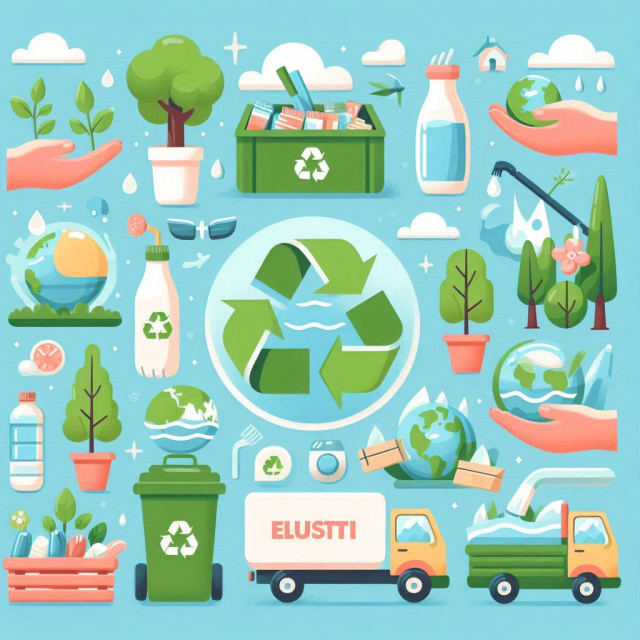Caring for nature is essential to maintain ecological balance and ensure the survival of all life forms on Earth, including humanity. With growing concerns about climate change, biodiversity loss and environmental degradation, it is more important than ever to adopt sustainable practices. In this article, we will explore various ways to care for nature, from individual actions to community initiatives and global policies.
Reduce, Reuse and Recycle.
One of the most effective ways to take care of nature is by implementing the three Rs: reduce, reuse and recycle.
Reduce.
Reducing resource consumption is essential. This includes minimizing the use of single-use plastics, opting for products with less packaging, and buying only what you need. Adopting a minimalist lifestyle not only reduces the amount of waste we produce, but also decreases the demand for natural resources.
Re-use.
Reusing products is another effective way to reduce environmental impact. Opting for durable products instead of disposable ones, donating clothes and objects instead of throwing them away, and repairing instead of replacing are practices that extend the life of items and reduce the need to produce new ones.
Recycle.
Recycling helps reduce the amount of waste that ends up in landfills and allows valuable materials to be recovered. It is important to properly separate waste and know local recycling regulations to ensure that materials are processed correctly.
Water Conservation.
Water is a vital resource that we must conserve. There are several ways to reduce water consumption and protect this essential resource.
Efficient Use of Water.
Adopting habits like turning off the faucet while brushing your teeth, taking shorter showers, and fixing water leaks can make a big difference. Additionally, using water-efficient appliances, such as washing machines and dishwashers, also helps conserve water.
Rainwater Harvesting.
Installing rainwater collection systems for use in gardening or outdoor cleaning is an effective way to take advantage of this natural resource and reduce dependence on drinking water.
Protection of Water Sources.
Protecting rivers, lakes and aquifers from pollution is crucial. This includes preventing the discharge of chemicals and waste into water systems and supporting local and global water conservation policies and projects.
Promote Biodiversity.
Biodiversity is vital for the health of ecosystems. There are several ways to promote and protect biodiversity in your environment.
Plant Native Trees and Gardens.
Planting trees and gardens with native species helps provide habitats for local wildlife and maintain ecological balance. Trees also help mitigate climate change by absorbing carbon dioxide.
Create Habitats for Wildlife.
Creating spaces such as pollinator gardens, ponds and shelters for birds and small mammals in your garden can help local wildlife thrive. These habitats provide food, water and shelter for a variety of species.
Avoid the Use of Pesticides and Herbicides.
Excessive use of pesticides and herbicides can severely damage local ecosystems and kill beneficial species. Opting for more natural, less toxic pest and weed control methods helps maintain healthy biodiversity.
Sustainable Use of Energy.
Energy consumption is one of the largest contributors to climate change. Adopting sustainable practices in energy use is crucial to taking care of nature.
Renewable energy.
Installing solar panels or using wind energy to power your home with clean energy is an effective way to reduce greenhouse gas emissions. Additionally, choosing energy providers that offer renewable energy options contributes to the development of these technologies.
Energy efficiency.
Improving the energy efficiency of your home by using LED light bulbs, energy-efficient appliances and good insulation can significantly reduce energy consumption. Additionally, simple practices like turning off lights and electronic devices when not in use also make a big difference.
Sustainable transport.
Opting for sustainable means of transport such as walking, cycling, using public transport or car sharing reduces dependence on fossil fuels and reduces carbon emissions.
Sustainable Food.
Food production has a great environmental impact. Adopting sustainable eating practices can help reduce this impact.
Plant Based Diet.
Reducing your consumption of meat and animal products and opting for a more plant-based diet can decrease your carbon footprint and resource use. Meat production requires large amounts of water and feed and generates high methane emissions.
Buy Local and Seasonal.
Buying local and seasonal foods reduces the need for transportation and storage, which decreases carbon emissions. Additionally, supporting local farmers helps strengthen the regional economy and promotes sustainable agricultural practices.
Reducing Food Waste.
Planning meals, properly storing food, and using leftovers are effective ways to reduce food waste. Food waste not only wastes resources, but also contributes to greenhouse gas emissions when it decomposes in landfills.
Community Participation and Education.
Active participation in the community and education about the importance of caring for nature are essential to generate a significant impact.
Participate in Conservation Projects.
Getting involved in local conservation projects, such as reforestation, beach cleanups, or protection of natural areas, helps improve and maintain local ecosystems. These activities also foster a sense of community and environmental responsibility.
Environmental education.
Promoting environmental education in schools and in the community is crucial to raising awareness about the importance of protecting nature. Educational programs, workshops and awareness campaigns can equip people with the knowledge and tools necessary to adopt sustainable practices.
Support for Environmental Policies and Legislation.
Supporting policies and legislation that protect the environment is essential to generating large-scale change. This includes supporting laws that promote conservation, renewable energy and reducing carbon emissions, as well as voting for leaders who prioritize environmental sustainability.
Caring for nature requires a comprehensive approach that combines individual actions, community initiatives and global policies. Reduce, reuse and recycle, conserve water, promote biodiversity, use energy sustainably, adopt responsible eating and participate in education and community projects are crucial steps to protect our planet. By implementing these practices and fostering environmental awareness, we can contribute to a more sustainable and healthy future for all life on Earth. The responsibility of caring for nature falls on each of us, and our actions today will determine the world we leave for future generations.
